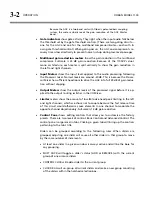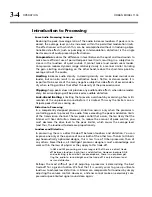
3-6
OPERATION
ORBAN MODEL 1100
utes of the sound field. Stereo enhancement can unnecessarily stress this encoding
process.
Starting with one of our suggested presets will help keep you out of trouble when
you edit them to create user presets.
We have supplied several presets tuned for the Microsoft WMA (V9) at 32 kbps. This
codec has severe artifacts (particularly with speech) at this bitrate and no preproc-
essing can mask them completely. The 1100’s WMA presets strictly limit the amount
of high frequency energy applied to the codec, so these presets will sound dull com-
pared to other OPTIMOD-PC presets. To prevent the processing from adding L–R en-
ergy, these presets operate with full stereo coupling and without stereo enhance-
ment.
Professional netcasters committed to providing their audiences with the
best audio possible at a given bitrate should consider the use of a higher
performance codec like Orban’s Opticodec-PC, which uses standards-
based MPEG-4 AAC/HE-AAC/aacPlus™. HE-AAC is the most efficient codec
available at the time of this writing. It can provide good entertainment-
quality audio at bit rates as low as 32kbps stereo or 24kbps mono, allow-
ing coverage of audiences listening on dial-up connections or via wireless
devices. The lower bitrates also penetrate crowded networks with fewer
audio interruptions.
OPTIMOD-PC’s ability to maintain source-to-source spectral consistency is also an
important advantage. Once you have set up the processing to minimize codec arti-
facts caused by a given piece of program material, OPTIMOD-PC’s will automatically
minimize codec artifacts with any program material.
Optimod-PC in Radio-Oriented Applications: From Bach to Rock
OPTIMOD-PC can be adjusted so that the output sounds:
•
as close as possible to the input at all times (using the Two-Band Protection Lim-
iter preset)
•
open but more uniform in frequency balance (and often more dramatic) than
the input (using the Two-Band structure or running the Five-band structure with
slow release time)
•
dense, quite squashed, and very loud (using the Five-band structure with faster
release times)
The dense, loud setup will make the audio seem to jump out of car and table radios,
but may be fatiguing and invite tune-outs on higher quality home receivers. The
loudness/distortion trade-off explained above applies to any of these setups.
In professional broadcasting environments, you will achieve best results if Engineer-
ing, Programming, and Management go out of their way to communicate and co-
operate with each other. It is important that Engineering understand the sound that
Programming desires, and that Management fully understands the trade-offs in-
volved in optimizing one parameter (such as loudness) at the expense of others
(such as distortion or excessive density).
















































